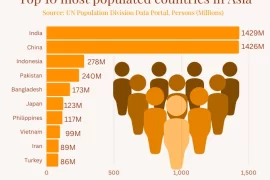Japan, the 8th most powerful country in the world, has recently announced plans to acquire hundreds of American-made Tomahawk cruise missiles, according to The New York Times. The purpose of this purchase is to enhance Japan’s capabilities for missile counterstrikes. Let’s take a closer look at how Japan is implementing this plan.
Kishida’s aggressive policy
Since taking office in 2021, Japanese Prime Minister Fumio Kishida has been pursuing an aggressive policy to significantly strengthen Japan’s defense capabilities.
While Japanese administration have been busy in reinterpreting the constitutional restrictions on the nation’s defense forces, the current Prime Minister is solidifying new military commitments.
On December 2, 2022, Japan’s ruling coalition of the Liberal Democratic Party (LDP) and its junior partner, the Komeito, approved Japan’s ability to strike enemy bases that are preparing to attack.
Japan also committed to spending 2% of its gross domestic product on its annual defense budget – amounting to some $320 billion which implies the world’s third largest defense budget.
Three key defense and security-related documents – the National Security Strategy, the National Defense Strategy, and the Defense Buildup Program – were approved by the Cabinet on December 16, 2022, which emphasize strengthening defense capabilities over the following five years.
According to Tsuneo Watanabe, a senior research fellow at the Sasakawa Peace Foundation in Tokyo, Japan’s three defense documents signal a shift in strategy as they recognize the possibility of a genuine military threat to Japanese territory.
Japan has announced its intention to acquire the ability to launch counterattacks and to enhance its ability to respond to new domains such as cyber and outer space in these strategic documents.
It is important to note that Japan’s current military expansion can be traced back to the tenure of former Prime Minister Abe Shinzo.
During his time in office, Japan implemented a significant increase in defense spending, approximately 10%, and made the historic decision to reinterpret the country’s post-WWII “peace constitution” to permit overseas deployment of the Japanese military.

Strengthening defense ties with the US
The United States is a major supporter and provider of the new plan to enhance Japan’s missile counterstrike capabilities.
The Biden administration welcomed Japan’s revisions to its national security documents, while China expressed dissatisfaction.
During Japanese Prime Minister Fumio Kishida’s recent visit to the US in January 2023, President Biden stated “We are modernizing our military alliance, building on Japan’s historic increase in defense spending and new national security strategy.”
The two leaders pledged to work together to transform Japan into a powerful military force to counterbalance China and strengthen the alliance between the two nations to become the cornerstone of their security interests in Asia.
The acquisition of counterstrike capabilities was a major topic during the recent 2-plus-2 talks (January 11, 2023) between the Japanese and US foreign and defense ministers, officially known as Japan-US Security Consultative Committee.
The United States promised to fully support Japan’s acquisition of these capabilities during the meeting.
The ministers also agreed that “attacks to, from or within space” could lead to the invocation of Article 5 of the Japan-U.S. Security Treaty, which stipulates the United States’ obligation to defend Japan.
Japan will also deepen cooperation with the United States to build an integrated air and missile defense system.
A revision of the Japan-U.S. defense cooperation guidelines, which outline the roles of Japan’s Self-Defense Forces (SDF) and the US military in peacetime and during an armed attack, will likely be considered once details regarding Japan’s acquisition of counterstrike capabilities are confirmed.
Key components of Japan’s missile counterstrike capabilities
Type 12 surface-to-ship guided missile
One of the main components of Japan’s missile counterstrike capabilities will likely be an improved version of the Ground Self-Defense Force’s Type 12 surface-to-ship guided missile.
This missile is Japan’s first domestically-made long-range cruise missile.
Deployment of the modified missiles is expected to begin in fiscal 2026 at the earliest.
Tomahawk Cruise Missiles
In addition, the Defense Ministry also plans to purchase American-made Tomahawk cruise missiles for use in counterstrike scenarios.
So far, the United States has only sold Tomahawks to Britain.
Kyodo News reported that Japanese Defense Minister Yasukazu Hamada announced on February 14, 2023 that the country intends to purchase all the Tomahawk cruise missiles it requires from the US in the fiscal year 2023 in a single transaction, instead of over several years as previously intended. This decision represents a substantial increase in Japan’s long-range missile capabilities, as the Tomahawk missile can reach a maximum range of 2,500 kilometers.
Construction of Mageshima Base
Japan has reportedly commenced construction of a new Self-Defense Forces base on Mageshima Island in Kagoshima, according to Jiji Press. The new base will facilitate field carrier landing practice for US carrier-based aircraft and serve as a supply and maintenance center for the protection of Japan’s southwestern Nansei Islands. The runway is anticipated to be completed first to enable early usage, with the entire construction project expected to take approximately four years.
To enhance targeting capabilities, Japan plans to launch a network of small satellites operating in unison to collect real-time information.
However, Japan currently relies on information provided by US satellites.
To increase long-distance strike capabilities against enemy bases, the Japanese government plans to include a “standoff missile unit” which will consist of seven surface-to-ship missile regiments, two high-speed gliding missile battalions for island protection, and two long-range guided missile troops, as reported by The Asahi Shimbun.







